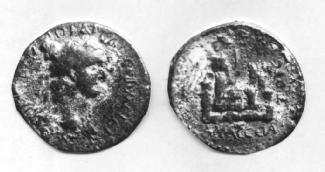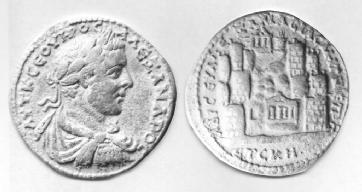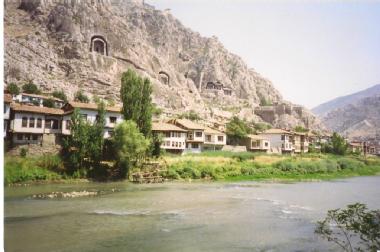Severus Alexander and Amaseia
 |
| Coin of Domitian showing the city of Amaseia |
Five hours east of Ankara by bus lies the modern provincial town of Amasya, perhaps better known today for the Ottoman houses that line its riverfront. In antiquity, as Amaseia, it owed its origins to the infighting that followed the division of Alexander’s empire and the power vacuums that sometimes developed. So for instance, on the death in 302 BC of Mithradates II of Cius, suspected of conspiring against Antigonus Monophthalmus, his son fled to Paphlagonia, occupied a stronghold at Cimiata and began the process of gaining control of the surrounding area, becoming in time Mithradates I Ctistes of Pontus. At some later stage the capital was moved to Amaseia itself, where the citadel formed an impregnable fortress from which to continue the expansion. By 250 BC it had acquired the coastal towns of Amastris, Amisus, and ultimately, in 183 under Pharnaces I, Sinope, which was to become the new capital of a kingdom now stretching from Amastris in the west to Trapezus in the east.
Nevertheless it is clear that in terms of royal associations, its strategic inland position, civic monuments and religion Amaseia continued to represent the true heart of Pontus, as its famous son, the geographer Strabo, makes clear (12, 3, 39):
My own city of Amaseia lies in a large and deep gorge through which flows the river Iris. As a result of both human ingenuity and nature it is wonderfully appointed, since at one and the same time it is able to serve as both city and fortress. For there is a high and precipitous rock which plunges down to the river, bounded on one side by the wall on the river’s edge, where the town is settled, and on the others by the walls that run up on either side to the peaks. There are two of these peaks which are connected to one another and rise up wonderfully to towering heights. Within this circuit of walls are the royal palace and the monumental tombs of the kings.
 |
| Coin of Severus Alexander showing the city of Amaseia |
Even today the rock-cut tombs, the platform of the palace and the walls remain visible, and it is these that were to figure on more than one issue of its coins. While the numismatic origins of Pontus remain a matter of debate, by the reign of Pharnaces I (c. 185-156 BC) its coinage was well established, with the mint most probably located in Amisus, which was to remain the main producer. Under Mithradates VI (c. 120-63 BC), however, Pontus experienced a veritable explosion in production in order to finance the three wars that Mithradates waged against Rome. In terms of gold and silver, issues offer important clues as to production schedules, with coins bearing not only the year of production according to the Pontic calendar, but even the month of production. Base-metal coinage, in turn, issued in a variety of denominations, has its own remarkable feature, in that issues bear the name of their ostensible origin, a total of fourteen locations, including Amaseia.
 |
| Rock cut tombs at Amaseia |
With the final collapse of the kingdom before the might of Rome there was an inevitable hiatus in the coin-record, with Amaseia ostensibly only re-emerging in the reign of Tiberius. Thereafter, however, production flourished as troops on the eastern frontier were periodically augmented and campaigns waged, and we find reverse motifs honouring at times not only the emperors of the day, but also gods such as Athena, Hades/Serapis, Apollo, Asclepius, Tyche and Ares with Aphrodite. Architecture too figures as a reverse motif in the form of a temple, perhaps that of Zeus-Stratios, a Hellenised version of the Persian Ahura-Mazda, which, with its associated fire-altar and adjacent tree, crowned the citadel. The altar and tree themselves form an important motif on several issues and mirrored, in fact, the sanctuary of the god which lay on a mountain peak to the east of the city and is associated with enormous sacrificial holocausts described by Appian (Mith. 66, 70) in the context of Mithradates VI’s defeat of Murena in 82 BC and the invasion of Bythinia in 74. A further temple, that of the Great Mother, is referred to by Gregory of Nyssa (De S. Theodoro Mart., Patrologia Graeca 46, p.744a), “There was a temple to the fabled Mother of the Gods in the metropolis of Amaseia, which the pagans of that time in the conceit of their folly built beside the banks of the river.”
The first representation of the city as a whole on coinage comes in the reign of Domitian (AD 81-96), a schematic view of towers along the city walls, a temple in the foreground, evidently that of the Great Mother, and on the summit of the citadel another with, to its left, seemingly, a representation of the altar and tree associated with Zeus-Stratios. The larger module issue of Severus Alexander, in contrast, (dated AD 225-6 – ET CKH) brings much of this into greater relief: to left and right the circuit of walls with their impressive towers, still visible to some extent today, in the foreground-centre, on the banks of what would be the river Iris, is clearly the temple of the Great Mother referred to by Gregory; to its left a rock-cut tomb, while above the cliff-face rises to the summit bearing more clearly this time the temple of Zeus Stratios, with a fire-altar to its right. Of this last edifice nothing remains today, replaced by the remains of Byzantine and later fortifications, hence the significance of the coin as an architectural point of reference.

The coin as selected by Stanley Ireland, Emeritus Reader in the department, is one of over 4,500 coins he catalogued in the museum at Amasya/Amaseia.
 Clare Rowan
Clare Rowan


 Loading…
Loading…
Add a comment
You are not allowed to comment on this entry as it has restricted commenting permissions.